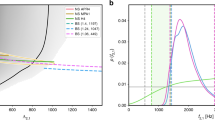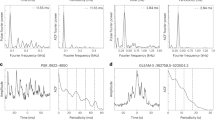Abstract
Statistical techniques are applied to asteroid orbital data in an attempt to define the characteristics of the Kirkwood gaps in the distribution of the asteroids. A significant tendency is found for the eccentricities and inclinations of asteroid orbits to increase away from the gaps. These effects are observed throughout the distribution of main-belt asteroids. They are not merely confined to the immediate vicinities of the resonances and are not caused by observational selection effects. There is no evidence that the magnitude–frequency distribution of the asteroids changes near the gaps. Evidence is given for the existence of gaps in Hirayama families, possibly of a different nature from the classical Kirkwood gaps at locations corresponding to high order commensurabilities with Jupiter. These results support the theory that the Kirkwood gaps were formed by gravitational processes acting on individual asteroids throughout their lifetimes.
This is a preview of subscription content, access via your institution
Access options
Subscribe to this journal
Receive 51 print issues and online access
$199.00 per year
only $3.90 per issue
Buy this article
- Purchase on Springer Link
- Instant access to full article PDF
Prices may be subject to local taxes which are calculated during checkout
Similar content being viewed by others
References
Kirkwood, D. Meteoric Astronomy (Lippincott, Philadelphia, 1867).
Greenberg, R. & Scholl, H. in Asteroids (ed. Gehrels, T.) 310–333 (University of Arizona Press, 1979).
Message, P. J. in The Theory of Orbits in the Solar System and in Stellar Systems (ed. Contopoulos, G.) 197–222 (Academic, London, 1966).
Schweizer, F. Astrn. J. 74, 779–788 (1969).
Wiesel, W. E. Celestial Mech. 13, 3–37 (1976).
Sinclair, A. T. Mon. Not. R. astr. Soc. 142, 289–292 (1969).
Brouwer, D. & Clemence, G. M. Methods of Celestial Mechanics (Academic, New York, 1961).
Williams, J. G. thesis, Univ. California (1969).
Williams, J. G. in Asteroids (ed. Gehrels, T.) 1040–1063 (University of Arizona Press, 1979).
Hirayama, K. Proc. phys. -math. Soc. Japan Ser. II, 9, 354–361 (1918).
Dermott, S. F. Nature phys. Sci. 244, 18–21 (1973).
Zellner, B. & Bowell, E. in Comets, Asteroids, Meteorites; Interrelations, Evolution and Origins (ed. Delsemme, A. H.) 185–197 (University of Toledo, 1977).
Lindgren, B. W. Statistical Theory (Macmillan, New York, 1960).
Kiang, T. Icarus 5, 437–449 (1966).
Kuiper, G. P. et al. Astrophys. J. Suppl. 3, 289–28 (1958).
Franklin, F. A., Lecar, M., Lin, D. N. C. & Papoloizou, J. Icarus 42, 271–280 (1980).
Chapman, C. R. in Asteroids (ed. Gehrels, T.) 25–60 (University of Arizona Press, 1979).
Gradie, J. & Zellner, B. Science 197, 254–255 (1977).
Gradie, J. thesis, Univ. Arizona (1978).
Steins, K. A. Astr. Zh. 33, 246–250 (1956).
Wiesel, W. Icarus 34, 99–116 (1978).
Author information
Authors and Affiliations
Rights and permissions
About this article
Cite this article
Dermott, S., Murray, C. Resonant structure of the asteroid belt. Nature 290, 664–668 (1981). https://doi.org/10.1038/290664a0
Received:
Accepted:
Issue Date:
DOI: https://doi.org/10.1038/290664a0
This article is cited by
-
On the dynamics in the asteroids belt. Part II: Detailed study of the main resonances
Celestial Mechanics and Dynamical Astronomy (1990)
-
A hyperbolic twist mapping model for the study of asteroid orbits near the 3?1 resonance
ZAMP Zeitschrift f#x00FC;r angewandte Mathematik und Physik (1986)
-
Nature of the Kirkwood gaps in the asteroid belt
Nature (1983)
Comments
By submitting a comment you agree to abide by our Terms and Community Guidelines. If you find something abusive or that does not comply with our terms or guidelines please flag it as inappropriate.



